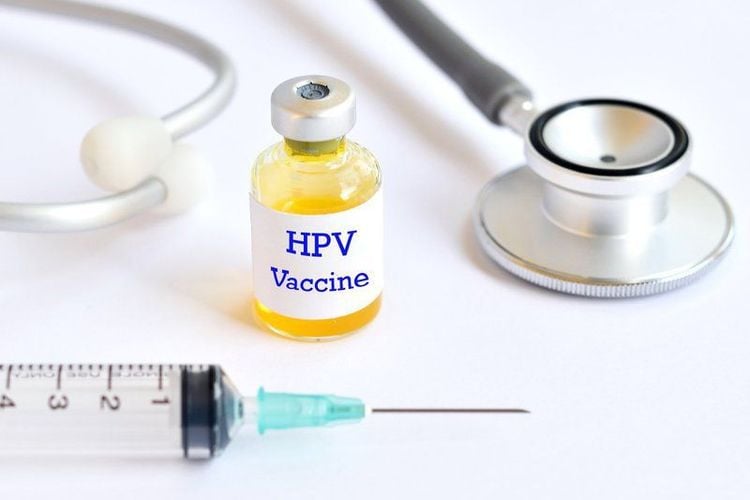This is an automatically translated article.
The article was written by Specialist Doctor I Nguyen Thi Minh Thuyen - Pathologist, Pathology Department - Vinmec Danang International General Hospital.Detecting cancer early leads to more treatment options. Some early cancers may have noticeable signs and symptoms, but that's not always the case.
1. Can cervical cancer be detected early?
The best way to detect cervical cancer early is to have regular checkups with a Pap test (maybe combined with a test for HPV). Being aware of any signs and symptoms of cervical cancer can also help avoid delays in diagnosis. Early detection greatly improves the chances of successful treatment of pre-cancers and cancers.
1.1 American Cancer Society Guidelines for the Prevention and Early Detection of Cervical Cancer
The American Cancer Society recommends that women follow these guidelines to help detect cervical cancer early. Following these guidelines can also detect pre-cancers, so that they can be treated promptly
All women should begin cervical cancer screening (screening) at age 21. Women ages 21 to 29 should have a Pap test every 3 years. HPV testing should not be used for screening in this age group unless there is an abnormal Pap test result. Beginning at age 30, women should be screened with a Pap test combined with an HPV test every 5 years as long as the test results are normal, and should continue until age 65. Another affordable option for women 30 to 65 is to have only a Pap test every 3 years. Women over 65 years of age who have had regular screening in the past 10 years with normal results should discontinue cervical cancer screening. Women with a history of advanced cancer, such as CIN2 or CIN3 should continue to be tested for at least 20 years, even after age 65. Women who have had a complete hysterectomy (removal of the uterus and cervix) should stop screening (such as Pap tests and HPV testing), unless the hysterectomy is due to precancerous conditions (or cervical cancer. Women who have had a hysterectomy without removal of the cervix should continue to be screened for cervical cancer according to the guidelines above. Women at high risk for cervical cancer because of a suppressed immune system (eg, due to HIV infection, organ transplantation, or prolonged steroid use) or because they are exposed to DES in utero may need check more often. They should follow the recommendations of a healthcare professional. Women of all ages should NOT be screened annually by any screening method if their Pap test is normal and they do not have HIV or other causes of a weakened immune system. Women who have been vaccinated against HPV should still follow these guidelines for their age groups. Some women believe they can stop cervical cancer screening when they stop having children. This is not correct. They should continue to follow the guidelines of the American Cancer Society.
Although annual screening is not recommended, women with abnormal screening results may need a follow-up Pap test (sometimes HPV test) in 6 months or a year.
The American Cancer Society guidelines for early cervical cancer detection do not apply to women who have been diagnosed with cervical cancer or pre-cancer of the cervix. These women should have follow-up testing and cervical cancer screening as recommended by their healthcare professional.

Phụ nữ nên được tiêm phòng HPV
1.2 Importance of cervical cancer screening
Cervical cancer used to be one of the leading causes of death among women worldwide. Cervical cancer morbidity and mortality decreased significantly with increased Pap testing for screening.
Screening tests offer the best chance of finding cervical cancer early and possibly treating it most successfully. Screening can actually prevent most cervical cancers by finding abnormal (precancerous) cell changes in the cervix that can be treated before they have a chance to progress. develop into cervical cancer.
Despite the many benefits of cervical cancer screening, not all women are screened. Most cervical cancers are found in women who have never or recently had a Pap test.
1.3 Cervical cancer screening test
The best way to detect cervical cancer early is to have regular checkups with a Pap test (maybe combined with a test for HPV). As Pap testing becomes routine, detecting pre-invasive (cervical) lesions of the cervix has become much more common than detecting invasive cancer. Being alert to any signs and symptoms of cervical cancer can also help avoid unnecessary delays in diagnosis. Early detection greatly improves the chances of successful treatment and can prevent early cervical cell changes from becoming cancerous.
HPV DNA test Doctors can now test for strains of HPV (high-risk types) that can cause cervical cancer by looking for fragments of their DNA in cervical cells. The test may be done at the same time as the Pap test.
Pap test (Papanicolaou) A Pap test is a method of collecting cells from the cervix and observing them under a microscope in a laboratory to look for cancer and pre-cancers.
Abnormal Pap Test Results The first step in finding cervical cancer is usually an abnormal Pap test result. This will lead to further tests, which can diagnose cervical cancer.
2. Signs and symptoms of cervical cancer
Women with early and precancerous cervical cancer often have no symptoms. Symptoms usually do not begin until the tumor is larger and has grown into surrounding tissue. When this happens, the most common symptoms are:
Unusual vaginal bleeding, such as bleeding after vaginal sex, bleeding after menopause, bleeding and blood clots between the vaginas Menstrual cycles, or menstrual periods that are longer than usual, may also bleed after douching. Abnormal vaginal discharge - discharge that may contain some blood and may occur between menstrual cycles or after menopause. Pain during intercourse Pelvic pain Signs and symptoms as the disease progresses may include:
Swollen feet Problems urinating or having a bowel movement Blood in the urine These signs and symptoms may also due to problems other than cervical cancer. However, if you have any of these symptoms, see your doctor right away. Ignoring symptoms can cause the cancer to progress to a more advanced stage and reduce the chances of successful treatment.
For the best chance of successful treatment, don't wait for symptoms to appear. Get regular screening tests.

Đau khi quan hiệu có thể là dấu hiệu ung thư cổ tử cung
3. Cervical Cancer Test
The first step in finding cervical cancer is usually an abnormal Pap test result. Further tests will then be done that can diagnose cervical cancer.
If you have symptoms such as abnormal vaginal bleeding or pain during sex, your gynecologist will usually order the necessary tests to diagnose pre-cancer and cancer.
If diagnosed with invasive cancer, your doctor should refer you to a gynecological oncologist, who specializes in cancers of the female reproductive system.
3.1. For women with cervical cancer symptoms or abnormal Pap results
Medical history and physical exam First, your doctor will ask about your personal and family history. This includes information regarding cervical cancer risk factors and symptoms. General health check to assess your general health. Your doctor will do a pelvic exam and may do a Pap test if not already done. Also, examine the lymph nodes to look for signs of metastasis (the spread of cancer).
The Pap test is a screening test, not a diagnostic test. It does not say for sure that you have cervical cancer. An abnormal Pap test result means more testing is needed, to see if cancer or pre-cancer is indeed present. Follow-up tests include colposcopy (with biopsy), curettage, and apical biopsy.
Colposcopy If you have some symptoms that suggest cancer or if your Pap test results show abnormal cells, you will need a colposcopy. You will lie on the table as you would during your gynecological exam. Your doctor will place a speculum into your vagina to help keep it open during colposcopy. A colposcope is an instrument that is on the outside of the body and has a magnifying lens that helps the doctor see the surface of the cervix clearly. This procedure is safe to do even if you are pregnant. As with the Pap test, it is better not to have a colposcopy during your period.
The doctor will apply a mild acetic acid solution (similar to vinegar) to the cervix to make it easier to see the abnormal areas. If an abnormal area is found, the doctor will do a biopsy (remove a small piece of tissue). This tissue sample will be sent to a laboratory for thorough analysis. A biopsy is the best way to know for sure if an abnormal area is precancerous or cancerous. Although colposcopy is usually painless, a cervical biopsy can cause some discomfort, cramping, bleeding, or even pain in some women.
Types of Cervical Biopsy Some biopsies can diagnose precancerous and cancerous cervix. If a biopsy can completely remove all abnormal tissue, it may be the only treatment needed.
Colposcopy biopsy: With this biopsy, the cervix is first examined with a colposcope to look for abnormal areas. Using biopsy forceps, cut a small section of the abnormal area on the surface of the cervix. May cause mild cramping, little pain, and light bleeding afterward.
Cervical canal curettage: If colposcopy does not reveal any abnormal areas or if the transition zone (the area at risk of HPV infection and pre-cancer) cannot be visualized, an alternative approach is required. Check the area for damage. This means inserting a narrow instrument (either a curette or a brush) into the cervical canal (the part of the cervix closest to the uterus). Curettes or brushes are used to scrape the inside of the canal to remove some tissue, and it is sent to a laboratory for examination. After this procedure, patients may feel some cramping, and they may also experience light bleeding.
Cervical cone biopsy: This procedure, also known as a cone, removes a sample of a cone model from the cervix. The base of the pyramid is the ectopic neck (the outer part of the cervix), and the top of the pyramid is the inner cervical canal. The tissue taken in the cone includes the transition zone (the boundary between the lateral and medial necks, where precancerous lesions and cervical cancer begin). Apical resection may also be a treatment for the complete removal of many precancerous lesions and some very early cancers.
Commonly used procedures for apical resection are loop electrosurgical excision procdure (LEEP = large loop excision of the transformation zone (LLETZ), and cold knife apical excision.
Electrocautery apex (LEEP, LLETZ): In this approach, tissue is removed with a thin loop of wire that is heated electrically and acts like a small knife. During the procedure, regional anesthesia is required, and can be done in the office. Cold knife apex: This procedure needs to be done in a hospital. Use a scalpel or laser to remove tissue instead of a hot wire. You will be given anesthesia during the surgery (general anesthesia, either spinal or epidural). Possible complications of a conical resection include bleeding, infection, and cervical stenosis. Contouring methods won't prevent most women from getting pregnant, but if large amounts of tissue are removed, there may be a higher risk of preterm birth.

Khoét chóp có thể dẫn đến biến chứng sinh non
3.2. For women with cervical cancer
If the biopsy identifies cancer, your doctor may order some more tests to see how far the cancer has spread. Many of the tests described below may not be necessary for every patient. Decisions about the use of these tests are based on the results of a physical exam and biopsy.Cystoscopy, proctoscopy and examination under anaesthesia Often performed in women with large tumors. They are not needed if the cancer is found early.
During cystoscopy, a thin tube with a lens and light is placed into the bladder through the urethra. This allows your doctor to examine your bladder and urethra to see if cancer has invaded these areas. A biopsy may be done during cystoscopy for testing. Cystoscopy can be performed under local anesthesia, but some patients may need general anesthesia. Your doctor will let you know what to expect before and after the procedure. Colonoscopy: An examination of the rectum through a lighted tube to look for cervical cancer invasion into the rectum. Your doctor may also do a pelvic exam while you're under anesthesia to see if the cancer has spread beyond the cervix. Imaging If your doctor finds cervical cancer, some more imaging tests are needed. These tests can show whether the cancer has spread and will help you and your doctor decide on a treatment plan.
Chest X-ray : Detects whether cancer has spread to the lungs. Computed tomography (CT): If the tumor is larger or if there is concern about the cancer spreading. Magnetic resonance imaging (MRI): An MRI that analyzes soft tissues is sometimes better than other imaging tests, like a CT scan. Your doctor will decide which imaging test is best for your situation. Positron emission tomography (PET scan): For a PET scan, a mild form of radioactive sugar (called FDG) is injected into the bloodstream and is seen mainly in cancer cells. PET/CT scan: Often a PET scan is combined with a CT scan using a special machine that can do both at the same time. This allows the doctor to compare areas of higher radioactivity on PET scans with more detailed images on CT scans. This is the type of PET scan commonly used in patients with cervical cancer.

Bệnh nhân được chỉ định chụp MRI để chẩn đoán chính xác bệnh
To meet the needs of women for gynecological cancer screening, Vinmec International Hospital currently provides a screening package and early detection of gynecological cancer, helping to detect 4 diseases early: Cancer cervical cancer, breast cancer, uterine cancer and ovarian cancer even if the patient has no symptoms.
The subjects who should use the Gynecological cancer screening and early detection package include:
Female customers, over 40 years old Customers wishing to be able to screen for pathology of breast-gynecological cancer (neck) uterus, uterus, ovaries) Customers at high risk of cancer – especially customers with a family history of breast cancer, gynecology Women of reproductive age, perimenopause Menopause and menopause Women are having symptoms of breast cancer, gynecology such as: pain in the breast, lump in the breast, bleeding outside the menstrual cycle, abdominal pain, etc... To register for an examination and treatment at Vinmec International General Hospital You can contact Vinmec Health System nationwide or register online HERE.
Articles refer to the source: American Cancer Society
MORE:
Signs of cervical cancer women do not ignore Cervical cancer treatment in stages Causes of cervical cancer What is bow?














